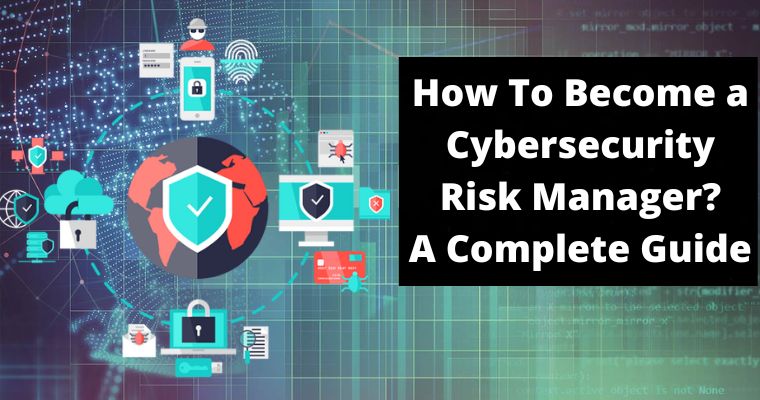Identifying, measuring, and managing the different risks to which the firm may be exposed is essential for running a successful organization.
Failure to recognize and plan for risk may lead to the demise of a business and this is where the role of the cybersecurity risk manager comes into play
The business risk profile (threats to which a firm is exposed) is strongly connected to cybersecurity and data protection for organizations that deal largely with data and information.
For organizations that deal primarily with tangible goods and services, risks are frequently connected to safety and security.
There are four types of hazards that all businesses must handle, regardless of their industry. These include, as well as some of their subcategories:
- Risk in the Market
- Rates of interest and currency exchange
- The cost of materials is always changing.
- Changing trade regulations
- Regulations on Compliance
- Risk of Credit
- Defaults by customers
- Vendor partnerships
- Operational danger
- Fraud
- Business and Employment Practices
- Processes of continuity
- Employee safety and security are paramount.
- Data and property protection
- Risk to Your Reputation
- Perception of the brand
- Breach or disclosure of personal information
Table of Contents
What is Cybersecurity Risk Management All About?
Risk management is a job that takes place on the front lines of the continuing cyber battle. To lead the path and keep your organization safe, you must be rational, analytical, and level-headed.
The role of a security risk manager is to detect and prioritize risks to a company’s security and assets (i.e., networks, servers, and data).
This entails developing, implementing, and enforcing IT policies that everyone must follow, such as password, encryption, and firewall regulations.
A risk manager must also create a security escalation mechanism, conduct ongoing evaluations, and maintain vigilance throughout the whole team.
As a result, you’ll need to be a problem solver as well as a communicator and a leader.
Who is a Cybersecurity Risk Manager?
A corporate risk manager is involved in a variety of commercial activities. The risk manager should always be in an executive position in the company.
Risk management is raised to the C Suite in certain organizations, with the chief risk officer (CRO) job. The risk manager’s position in the company’s hierarchy is frequently a reflection of the company’s risk appetite or readiness to take specific risks.
In simple terms, a risk manager’s job is to figure out what may go wrong and what the ramifications or impact on the firm would be if it did.
The dangers are the “what could go wrong” possibilities. A threat’s “consequences or impact” is referred to as security risk management.
In addition to comprehending the criticality of the numerous risks confronting the corporation, the risk manager must comprehend the likelihood of a specific hazard occurring.
Risk = Threat x Probability x Criticality is the primary formula used by managers. Risk = Threat x Vulnerability x Consequence may also be written as Risk = Threat x Vulnerability x Consequence.
Risk managers must keep an eye on both external and internal variables that may impact their firm to be effective.
Job titles in risk management include:
- Manager of security
- IT risk and security expert
- Manager of Risk
- Officer in charge of information security
- CISO
- Architect for Security
On-Duty Responsibilities of a Cybersecurity Risk Manager
A risk manager defines the company’s risk appetite in addition to recognizing the company’s risk. This is accomplished through devising ways to reduce, eliminate, or transfer risk.
Some risks are small, either because the effects are minor or because the likelihood of an occurrence is low. The firm may just accept such hazards, or in other words, they may simply take the risk.
Other hazards, on the other hand, must be avoided or transferred through insurance.
A risk assessment is used to quantify and convey threats and risk factors. A risk assessment is a tool that risk managers use to analyze known risk variables and compare them to known likely effects.
A risk assessment is used to come up with the best strategies to remove or reduce risk.
Risk managers must be prepared to advise corporate leadership on a possible course of action in the face of hazards ranging from weather and natural disasters to civil unrest and prospective rival mergers and acquisitions.
The risk manager may be able to rely on feedback from colleagues and subordinates in well-staffed companies, such as:
- Cybersecurity experts
- Director of security
- Officer in charge of information
- Specialists in threat intelligence
- Officer in Charge of Resilience (commonly found in municipalities)
The risk manager’s job is to assess information from all available sources and then quantify risks for the company’s senior decision-makers. They frequently help top management in developing risk-avoidance or risk-mitigation strategies.
Cybersecurity Risk Manager: Skills & Required Experience
While risk management professions may be found in a variety of sectors and organizations, some fundamental skills and experiences will benefit all risk managers. These are some of them:
- Ability to objectively assess facts and information in order to create a big-picture view of risk
- comprehensive understanding of their industry, including rivals and opponents
- At the executive level, the ability to communicate effectively is essential.
- The ability to react quickly to changes in the business environment.
- Leadership and organizational skills.
Job Description of a Typical Cybersecurity Risk Manager
The risk manager’s job is to create and convey an organization’s risk policies. They create risk models for market, credit, operational, and reputational risks.
To assess suitable risk acceptance, reduction, elimination, or transference methods, they use the risk formula (Risk = Threat x Probability x Criticality).
Typical responsibilities include:
- Creating and implementing a risk management strategy
- Perform or supervise risk assessments to ensure that all company hazards are addressed.
- Define the risk appetite of the company.
- Budgets for risk management and insurance should be prepared and balanced.
- Procedures for risk reporting should be defined.
- Stakeholders should be informed about risk policies.
- Plan for business continuity and approve it.
- Ensure that the company’s health and safety plans are followed.
- Conduct compliance audits or supervise them.
- Examine important contracts and proposals.
- The following is a current job description seen on the main job website.
The selected applicant will monitor and manage equity portfolio risk, scenario analysis, multi-factor modeling, and tail-risk analysis in this high-profile position.
On all equity risk-related topics, the Risk Manager will meet with portfolio managers and senior management on a regular basis.
The ideal applicant will have a master’s degree in a quantitative area and at least five years of risk and quantitative analysis experience with a reputable asset manager. A critical necessity is extensive factor modeling knowledge.
A thorough understanding of fundamental stock trading techniques is essential. The ability to program in Python or R is greatly preferred.
Because continuous engagement with the desk and senior management is a key element of this position, clear, deliberative, and intelligent communication skills are essential.”
A job description for a risk manager in another sector might be substantially different. However, some intriguing parallels are likely to persist. It’s important to note that the recruiting firm’s operation requires “deep knowledge and basics.”
This is a necessity that should be anticipated in any sector. It’s also worth noting that communication skills and the capacity to work with top management are prerequisites.
Possible Benefits of Cyber Security Risk Management!
The department of Cybersecurity Risk Management guarantees that cybersecurity (as a whole) is not treated as an afterthought in an organization’s daily life and regular operations.
A Cybersecurity Risk Management plan guarantees that processes and regulations are followed at regular intervals and that security is maintained.
The following dangers are continuously monitored, identified, and mitigated through Cybersecurity Risk Management:
• Detection of Phishing
• Protection for VIPs and executives
• Defending your brand
• Anti-fraud measures
• Data Leakage Monitoring for Sensitive Information
• Activity on the Dark Web
• Threat Mitigation that is Automated
• Monitoring of Leaked Credentials
• Detection of Malicious Mobile Apps
• Risks in the Supply Chain
Educational Requirements
Formal Education
Bachelor’s degree: Most employers consider a bachelor’s degree the minimum requirement. Ideally, this degree should be in cybersecurity, computer science, information technology, management or business administration.
Specialized cybersecurity programs often provide foundational knowledge in network security, risk management, and digital forensics.
Master’s degree (optional): While not universally required, a master’s degree in cybersecurity, risk management, or business administration can significantly enhance your profile and open doors to leadership positions.
Dual degrees: Earning a law degree alongside a cybersecurity degree or certificate provides a comprehensive understanding of both legal and technical aspects of cyber risk.
Because a deep understanding of unique business subtleties is required, the risk manager’s training and educational needs will vary greatly depending on the industry and organizational type.
Optional Certifications
There are some risk management certifications offered by the Professional Risk Managers’ International Association (PRMIA).
As risk managers advance in their careers, certification is also very sought. The following are some of the most at-risk certifications:
- CISSP (Certified Information Systems Security Professional)
- CGEIT
- ITIL Expert
- CISA (Certified Information Systems Auditor)
- GSLC
- PMI-RMP
- CRISC (Certified in Risk and Information Systems Control)
Certain risk management jobs may require particular credentials, such as the American Hospital Association’s Certified Professional in Healthcare Risk Management (CPHRM).
Career Outlook for Cybersecurity Risk Managers
The risk manager’s long-term prospects are bright. Risk management as a profession is still developing.
Many businesses dealt with risk in a siloed manner for many years, with each office, branch, division, or plant manager in charge of their own local hazards.
Only in the last two decades have businesses accepted the concept of a company-wide CEO with authority and accountability.
“The general job prognosis for risk management expert professions has been good since 2004,” according to Recruiter.com two years ago.
During that period, job openings for this profession have risen by 29.04 percent nationwide, with an average annual growth rate of 4.84 percent.
The need for Risk Management Specialists is anticipated to increase, with 11,760 new jobs likely to be filled by 2018. Over the following three years, this implies an annual rise of 0.95 percent.”
What is The Average Salary in the US for a Risk Manager?
“As of June 28, 2020, the average risk manager pay in the United States is $111,755, although the range generally falls between $96,890 and $127,939, according to salary.com.
“Many key aspects influence salary ranges, including schooling, certifications, extra talents, and the number of years you’ve worked in your field.”
Risk managers are lumped in with other types of financial managers by the Bureau of Labor Statistics. Risk management wages vary depending on the industry or firm in which they work.
- $127,960 is the average yearly pay.
- Pay in the top ten percent of the yearly salary scale: Approximately $208,050
- Annual pay in the bottom 10.5%: $67,630 or less
Risk managers’ compensation packages typically surpass financial managers’ compensation packages on average. In addition to salary, employees in this field may get bonuses and commissions and profit-sharing.
The average risk manager pay, according to Payscale.com, is $86,840, although the location will definitely affect overall compensation.
Risk managers, on the whole, are highly respected and well-compensated. A security risk manager earns an average of $84,537 a year, according to another survey. A CISO’s average pay is $160,855.
Cybersecurity Risk Management: In a Nutshell
Managing the risk presented by inadequate cybersecurity defenses is a continuous element of all corporate activities.
The dangerous environment is always shifting. New exploits are found, and patches to address them are published. New potentially susceptible devices are regularly introduced to the network, increasing the attack surface.
This is especially true given the rapid proliferation of the Internet of Things (IoT) devices and sensors in a variety of physical places.
A job in risk management necessitates both technical expertise and excellent interpersonal abilities.
Auditing, forensics, consultancy, and web development are just some of the options. Information security is a rapidly expanding topic since new technology constantly introduces new flaws.
FAQs
What is a Cybersecurity Risk Manager?
A cybersecurity risk manager is a professional responsible for identifying, analyzing, and mitigating cybersecurity risks within an organization. They play a crucial role in protecting sensitive data, systems, and infrastructure from cyberattacks and other threats.
Is Cybersecurity Risk Management a Good Career?
The answer, like most professions, is subjective. Risk and security professionals, on the whole, are paid well and have a high degree of job satisfaction. However, it appears to come at a cost: the hours are frequently long, and the stress level is high.




